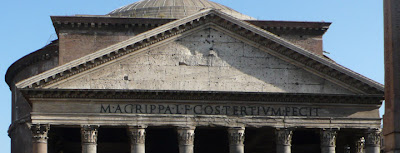I
Have a Theory
About that portico…. There are two types of
classical architects, those who are troubled by the portico of the
Pantheon—more specifically, its somewhat awkward relation to the intermediate
block between it and the rotunda—and those who are not. I have been, it should
be said, one of the latter, but I cannot help taking account of the many
arguments against the portico, especially those of Mark Wilson Jones. So, in
light of my meditations on emulation, let me offer a theory that might explain
the anomalies as intentional, perhaps even essential to the building’s meaning.
Caveat lector: what follows is mere
speculation. But in a case where no documentation exists as to intent, other
than the material remains themselves, what else is one to do? The question is,
does an explanation resolve a question in way that is, if not efficient, at
least effective in tying up as many loose ends as possible (Ockham’s razor). I
hope the following measures up.
Let’s
start with the “dedication,” which fooled so many for so long. In no other case
does a Hadrianic building invoke an older dedication so explicitly and
prominently. Why would Hadrian have done it? To mask the innovation of his
newer rotunda? Perhaps, but what if that dissembling were driven by a
concomitant desire to recreate or rebuild what had actually been there, and
append to it his own contribution? Little is known about the Augustan Pantheon,
but it is presumed to have been a fairly canonical Roman temple, with portico
and rectangular cella like the temple of Mars Ultor in the Forum of Augustus.
Augustus
did, of course, defeat Marc Antony and Cleopatra’s forces at the battle of
Actium, and thus absorbed definitively Egypt into the Roman Empire. What better
way to concretize that absorption than a temple portico, its column shafts made
of Egyptian granite? This early exercise in Egyptian import might explain the
imprecision in the column shafts.
 So,
here is my conjecture about the Pantheon’s portico: that it is a literal, not
metaphorical, rebuilding of the portico of the older temple destroyed by fire,
and the employment of spolie from
that building explains the lack of reconciliation with the intermediate block,
and the discrepancies of column shalf/capital heights noted
recently by Lothar Hasselberger. As reconstruction, it was allowed to
be—even demanded to be—distinct or detachable from the rotunda-cum-block
erected behind. The anomalies at the juncture, therefore, are not problems, but
deliberate accentuations of differences.
So,
here is my conjecture about the Pantheon’s portico: that it is a literal, not
metaphorical, rebuilding of the portico of the older temple destroyed by fire,
and the employment of spolie from
that building explains the lack of reconciliation with the intermediate block,
and the discrepancies of column shalf/capital heights noted
recently by Lothar Hasselberger. As reconstruction, it was allowed to
be—even demanded to be—distinct or detachable from the rotunda-cum-block
erected behind. The anomalies at the juncture, therefore, are not problems, but
deliberate accentuations of differences.
This
would be wholly within the framework of ancient understandings of emulation,
neither archeological nor radical. They juxtapose and integrate disparate
pieces to form a more ambitious whole. Se
non è vero, è ben trovato.
 PS: my book The Challenge of Emulation in Art and Architecture is scheduled to be published by Ashgate (UK) in November 2013
PS: my book The Challenge of Emulation in Art and Architecture is scheduled to be published by Ashgate (UK) in November 2013 

No comments:
Post a Comment